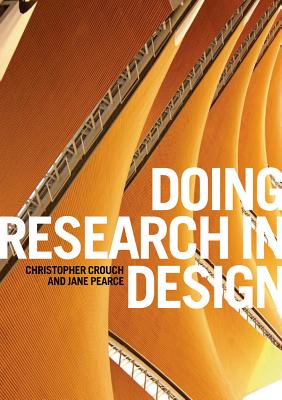 By Holly Willis
By Holly Willis
This semester, I’m teaching a course titled Seminar in Media and Design Studies, which is a methodologies course for doctoral students in the practice-based Media Arts + Practice program in the School of Cinematic Arts at the University of Southern California. In designing the course, I had a lot of trouble identifying a good, foundational text that would clearly outline what’s at stake for practitioners in thinking about a methodology. I wanted a text that is at once practical but also one that understands the need for us to be aware of our theoretical stance. This critical self-awareness is often missing in discussions of methodologies. Luckily, a colleague pointed me to Christopher Crouch and Jane Pearce’s new book, Doing Research in Design, which offers a terrific tool for understanding research in the context of design.
The book’s strength are its clarity and its perspective, which insists that we acknowledge the intersection of design research with materials, ideas and systems. We’re not simply individuals asking questions, but participants in networks, conversations and political contexts. The book’s first chapter centers on positioning the designer within social and cultural contexts. The authors underscore the ways in which who we are and what we do are always social, and suggest that designers need to understand this first and foremost. Crouch and Pearce help readers achieve this understanding by charting a trajectory through philosophy and critical theory to show how we’re deeply connected to a world of ideas.
The authors also introduce a useful vocabulary, supplying terms to help us be more specific as we think about design research. These terms include reflexivity, borrowed from Anthony Giddens and Pierre Bourdieu, to describe how we become aware of context. They also introduce Bourdieu’s notions of habitus and field from his 1984 book, Distinction: A Social Critique of the Judgment of Taste. “The field is a space that is demarcated by individuals and their actions, institutions and their debates,” they write, adding, “Individuals within the field are so caught up with that field’s practices, both emotionally and intellectually, that they start to live within the confines of the field and its values. They begin to inhabit that field ‘like a garment’” (11). This is significant in the context of research because we need to know how our own values are influencing what we’re doing.
In Chapter 2: What Do Designers and Researchers Do? Thinking, Doing and Researching, Crouch and Pearce reiterate that the central concern of design is the transformation of the world but add that this transformation often occurs by asking questions and solving problems. The focus for this chapter, then, is on how questions get formed, and how designers may contribute a unique way of both asking and crafting questions. The authors point to Bryan Lawson and his 2008 book How Designers Think to map out the nature of problem and solution in design thinking. They also highlight the often celebrated work of Nigel Cross and his book Designerly Ways of Knowing, which reinforces Lawson’s notions about the co-evolution of the design problem and solution, and their dynamic relationship.
Chapter 3: Practice and Praxis, Reflection and Reflexivity looks at these two sets of interdependent terms. Crouch and Pearce define practice as “a body of knowledge that is in constant flux, responding to new material conditions and way s of thinking” (34). They add, “The tensions and contradictions within a practice are managed by the community that defines it” (34). Then they define theory as “a set of ideas developed to explain facts” (35). The key here is that some theories seem so self-evident as to be transparent. Citing Stuart Hall, they remind us that commonsense discourse seem unremarkable, and it’s hard for us to articulate how these ideas work, but being aware of this unremarkable framing is essential for good research.
At this point, the authors turn to Don Norman to reflect on how much the nature of design has changed over the last 30 years. “Don Norman has pointed out that as the conditions that formed designers in industrial societies (and their work, which was primarily focused upon physical products) has altered beyond recognition so, too, has their work. Yet we still think of the designer as someone who makes, rather than as someone who thinks” (36). The authors then examine tacit and explicit knowledge, arguing that practice is a combination of the two. They explore the word praxis, starting with Aristotle and making their way to Marx, who told us that praxis is the way we develop a “capacity for conscious creativity” (42).
Chapter 4: Thinking About Research: Methodology and Chapter 5: Doing Research: From Methodologies to Methods are terrific chapters focusing more specifically on what’s necessary as one begins to undertake a research project. The authors talk about determining one’s research position, and being overt about the theoretical lens that is adopted. Crouch and Pearce describe two possible lenses, the hermeneutic lens and the critical lens, with the hermeneutic tradition being devoted to interpretation and the critical lens querying power relations within social interactions.
This perspective is foreign to many discussions of research in the context of design, where so much about the social realm is assumed rather than interrogated. Crouch and Pearce are adamant about why we need to think about these things, writing, “The most important thing is to ensure that your methodological choices are clear, purposeful, coherent and ethical, and capable of enabling you to engage in the kind of inquiry you intend” (64). The book next four chapters examine specific methods, including ethnography, narrative, mixed methods and action research; the final chapter reflects on the writing process. While these chapters are useful, the real value of the book is the framing offered in its first half, and the commitment to developing a more thoughtful research stance. Getting students to think at this meta-level is crucial, but again, rarely happens.